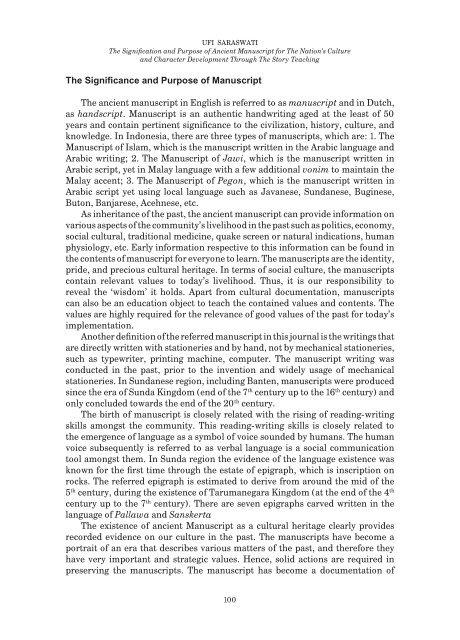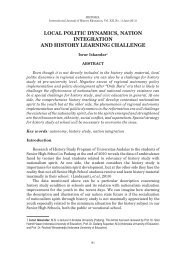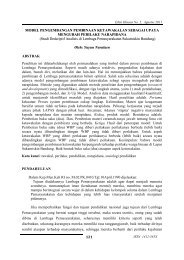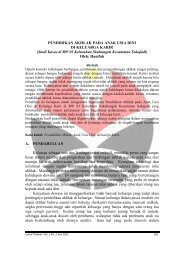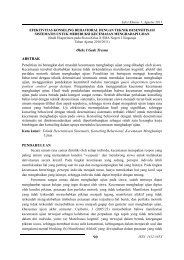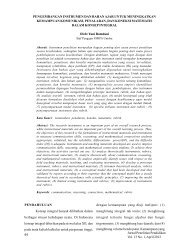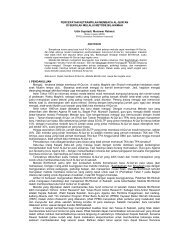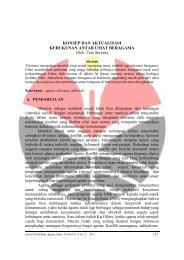Fulltext PDF - Jurnal UPI
Fulltext PDF - Jurnal UPI
Fulltext PDF - Jurnal UPI
Create successful ePaper yourself
Turn your PDF publications into a flip-book with our unique Google optimized e-Paper software.
UFI SARASWATI<br />
The Signification and Purpose of Ancient Manuscript for The Nation’s Culture<br />
and Character Development Through The Story Teaching<br />
The Significance and Purpose of Manuscript<br />
The ancient manuscript in English is referred to as manuscript and in Dutch,<br />
as handscript. Manuscript is an authentic handwriting aged at the least of 50<br />
years and contain pertinent significance to the civilization, history, culture, and<br />
knowledge. In Indonesia, there are three types of manuscripts, which are: 1. The<br />
Manuscript of Islam, which is the manuscript written in the Arabic language and<br />
Arabic writing; 2. The Manuscript of Jawi, which is the manuscript written in<br />
Arabic script, yet in Malay language with a few additional vonim to maintain the<br />
Malay accent; 3. The Manuscript of Pegon, which is the manuscript written in<br />
Arabic script yet using local language such as Javanese, Sundanese, Buginese,<br />
Buton, Banjarese, Acehnese, etc.<br />
As inheritance of the past, the ancient manuscript can provide information on<br />
various aspects of the community’s livelihood in the past such as politics, economy,<br />
social cultural, traditional medicine, quake screen or natural indications, human<br />
physiology, etc. Early information respective to this information can be found in<br />
the contents of manuscript for everyone to learn. The manuscripts are the identity,<br />
pride, and precious cultural heritage. In terms of social culture, the manuscripts<br />
contain relevant values to today’s livelihood. Thus, it is our responsibility to<br />
reveal the ‘wisdom’ it holds. Apart from cultural documentation, manuscripts<br />
can also be an education object to teach the contained values and contents. The<br />
values are highly required for the relevance of good values of the past for today’s<br />
implementation.<br />
Another definition of the referred manuscript in this journal is the writings that<br />
are directly written with stationeries and by hand, not by mechanical stationeries,<br />
such as typewriter, printing machine, computer. The manuscript writing was<br />
conducted in the past, prior to the invention and widely usage of mechanical<br />
stationeries. In Sundanese region, including Banten, manuscripts were produced<br />
since the era of Sunda Kingdom (end of the 7 th century up to the 16 th century) and<br />
only concluded towards the end of the 20 th century.<br />
The birth of manuscript is closely related with the rising of reading-writing<br />
skills amongst the community. This reading-writing skills is closely related to<br />
the emergence of language as a symbol of voice sounded by humans. The human<br />
voice subsequently is referred to as verbal language is a social communication<br />
tool amongst them. In Sunda region the evidence of the language existence was<br />
known for the first time through the estate of epigraph, which is inscription on<br />
rocks. The referred epigraph is estimated to derive from around the mid of the<br />
5 th century, during the existence of Tarumanegara Kingdom (at the end of the 4 th<br />
century up to the 7 th century). There are seven epigraphs carved written in the<br />
language of Pallawa and Sanskerta<br />
The existence of ancient Manuscript as a cultural heritage clearly provides<br />
recorded evidence on our culture in the past. The manuscripts have become a<br />
portrait of an era that describes various matters of the past, and therefore they<br />
have very important and strategic values. Hence, solid actions are required in<br />
preserving the manuscripts. The manuscript has become a documentation of<br />
100


